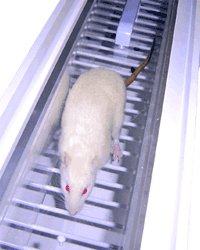
An entirely modular experimental enclosure designed to conduct operant conditioning procedures (e.g. food reinforcement, DMTS, conflict...
 Pain - Thermal Allodynia / Hyperalgesia
Pain - Thermal Allodynia / Hyperalgesia Pain - Spontaneous Pain - Postural Deficit
Pain - Spontaneous Pain - Postural Deficit Pain - Mechanical Allodynia / Hyperalgesia
Pain - Mechanical Allodynia / Hyperalgesia Learning/Memory - Attention - Addiction
Learning/Memory - Attention - Addiction Physiology & Respiratory Research
Physiology & Respiratory Research
An entirely modular experimental enclosure designed to conduct operant conditioning procedures (e.g. food reinforcement, DMTS, conflict...
Discover our productsA unique, automatic apparatus for the detailed and objective modeling of walking and coordination disorders in mice and/or rats, with respect to motor and psychomotor skills and cognition. An innovative and operator-independent solution for studies on myopathy, ataxia, alcoholism, Parkinson's and Huntington's disease, and much more.
![]()
![]()
![]() Presentation
Presentation

The Foot Misplacement Apparatus (FMA) is a unique system to objectively detect gait or walking disorders, abnormalities of coordination and motor or reflex problems in rodents (rat or mouse) in a highly accurate way, by recording the number, position and duration of errors of an animal walking in an opaque corridor on an horizontal ladder towards a dark compartment.
The ladder rungs can be removed to increase the difficulty of the exercise or create traps, and two sets of 77 infrared sensors are placed above and below the ladder to detect the subject’s movement and any paw misplacements.
The instrument allows you to quantify the recovery of sensorimotor activity, and is of particular interest for studies on myopathy, ataxia, alcoholism, Parkinson’s and Huntington’s disease, recovery from brain or spinal cord injuries, and much more !![]() Operating principle
Operating principle
A departure and an arrival box are located at opposite ends of a horizontal ladder encased in a corridor. Infra-red beams and sensors (-77 sets above and below the ladder) detect the subject’s movement along the length of the ladder and are used to recognize and record the exact position and duration of errors in motor coordination (missteps or paw slips between any 2 rungs). The included software differentiates among front and hind paw errors and erroneous tail errors.
The space between the rungs can be adjusted to increase the difficulty, and one or more rungs can be removed to create traps and assess cerebellar learning.
Data sheet
Number of publications:
An easy way to objectively quantify the muscular strength of mice and rats, and to assess the effect of drugs, toxins,...
The BIOSEB Spontaneous Activity Wheel is an easy way to quantify rodent voluntary activity in their home cage environment....
A unique setup for the automation of the Open Field test for rats and mice : 3D-camera based technology is now capable of...
check_circle
check_circle